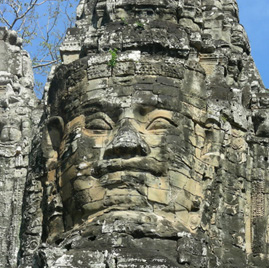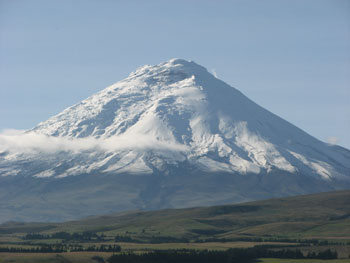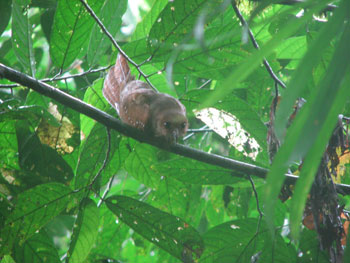|

 Karen's Perspective on Traveling Alone Karen's Perspective on Traveling Alone






















|
Hacienda Life in Otavalo
Let me be the first to wish you a very happy New Year from Otavalo, a lovely historic town 2 hours north of Quito. Imagine me in a room in a hacienda built in 1790 with 20 foot ceilings and Simon Bolivar type portraits all around and yes, with a computer and wi-fi to boot!
This hacienda is famous for its thoroughbred horses but I think I'll opt to try climbing one of the nearby volcanoes tomorrow. I have been having a fabulous time, especially since I FINALLY feel well after a nasty cold. I landed in Ecuador and slept for a few hours before meeting some interesting folks around dinner and the fire in my hostel. I spoke for a long time to a man in his 70's who wasn't interacting much with the 20 somethings surrounding us and I finally figured out that he didn't speak much English but was from Quebec. He reminded me so much of my uncle Carl and once we started speaking in Spanish we had a great time. Next was the 20 something Israeli woman who told me she had just visited Cuba for a few weeks, When I mentioned there was a live Cuban band that night she said "vamanos" and we had a marvelous time. Being older I would just pick out the men I wanted to dance with since they weren't probably going to ask me to dance. It was a great live band with a singer who resembled Celia Cruz and the best dancers in the house were 2 Afro-Ecuadorans whom I mistook for Cubans.
Andean Central Highlands
 The next day I traveled with some of the other folks from that hostel to another near Cotopaxi, the famed high volcano with year round snow. Along came my new best friend James Glanville, a 31 year old Brit who was a lawyer and traveling for a year. His name reminded me of those in E. M. Forester books. We shared lots of political talk and I ended up barely beating him at Scabble that night by using the word "yurt" which he righteously claimed was not a word but luckily it was in the dictionary we had. I also met 2 folks working for the Peace Corps in Honduras who both hope to go to graduate school in Berkeley and ended up traveling with them afterwards to the renowned Quilatoa Loop which is the Central Andean highlands and home of remote Andean towns. I met a brother sister pair (the Rabinovitzes) who were fascinating and plain fun. Judy is a top immigration lawyer for the ACLU in NY and bro Jonathon works for the Stanford School of Medicine as an editor and used to be a reporter for the NY Times and Mercury News. Judy of course knows Nancy from back in the day. We started at 16,400 feet to walk down from the Quilatoa lagoon to our guesthouse. I've never been, much less hiked at that altitude and I was dragging some of the time. But we had a clear day and the scenery was breathtaking (literally). We walked through the village of Guaymas where the local townfolks were getting ready for Christmas with a celebration that included Andean music and dressing up the sheep by stringing Christmas bulbs on them. They don't believe in gentle switchbacks here and by the time we arrived at our guesthouse 5 hours later, my knee was sore and aching. But after an hour on ice I was ready to dance later with my new friends and the one Latino staying where we were--a crazy Venezuelan man who had us laughing all night.
The next day I traveled with some of the other folks from that hostel to another near Cotopaxi, the famed high volcano with year round snow. Along came my new best friend James Glanville, a 31 year old Brit who was a lawyer and traveling for a year. His name reminded me of those in E. M. Forester books. We shared lots of political talk and I ended up barely beating him at Scabble that night by using the word "yurt" which he righteously claimed was not a word but luckily it was in the dictionary we had. I also met 2 folks working for the Peace Corps in Honduras who both hope to go to graduate school in Berkeley and ended up traveling with them afterwards to the renowned Quilatoa Loop which is the Central Andean highlands and home of remote Andean towns. I met a brother sister pair (the Rabinovitzes) who were fascinating and plain fun. Judy is a top immigration lawyer for the ACLU in NY and bro Jonathon works for the Stanford School of Medicine as an editor and used to be a reporter for the NY Times and Mercury News. Judy of course knows Nancy from back in the day. We started at 16,400 feet to walk down from the Quilatoa lagoon to our guesthouse. I've never been, much less hiked at that altitude and I was dragging some of the time. But we had a clear day and the scenery was breathtaking (literally). We walked through the village of Guaymas where the local townfolks were getting ready for Christmas with a celebration that included Andean music and dressing up the sheep by stringing Christmas bulbs on them. They don't believe in gentle switchbacks here and by the time we arrived at our guesthouse 5 hours later, my knee was sore and aching. But after an hour on ice I was ready to dance later with my new friends and the one Latino staying where we were--a crazy Venezuelan man who had us laughing all night.
It was there that I caught the cold, especially because the next day I started off in the freezing cold at 5am to catch a bus to Baños, a mostly touristy town that reminds me of Healdsburg but obviously not that wealthy. It is set in the valley surrounded by volcanoes and is famous for its hot springs. I tried out the public baths but they weren't really hot enough (except at night) so the next day I hired a taxi driver to drive me close to the volcano where we could hear its rumble and see the explosions. Except for Hawaii, I've never seen such an active volcano and I got some good photos. Then I paid to use a super expensive retreat for the day where I soaked in the tubs, ate an amazing lunch for Christmas Day and then met a young American who I hiked down the volcano with. I was still feeling lousy so went to bed early. I asked if there was an acupuncturist but that's the difference between Healdsbug and Baños. After a wonderful massage the next day, I spent a night tossing and turning and coughing and deciding I better see a doctor because I felt like my lungs were getting congested. I got up at 7am the next morning and walked the 3 blocks to the nearly hospital where a lovely woman doctor listened to my lungs and told me she thought I should take antibiotics so it didn't develop into bronchitis. I broke down and spent $16 (imagine the cost in the good ole USA--the doctor visit was free) and bought them and now, 5 days later, I'm feeling almost like myself again.
Birdwatching and Zip-Line in Mindo
I met up with the Rabinovitzes in Quito for a night and day and then decided to go to the bird mecca village of Mindo, about 2 hours west of Quito. It was on the bus that I met the first 4 Ecuadorian lesbians of the trip.--4 baby dykes who talked to me for a while and let me use their cell phone to make a few calls. I spent the last 3 nights at a wonderful guesthouse called Septimo Paraiso (7th heaven). On my 50th birthday I got up at 5am to go birding and see the famous "cock of the rock" a rowdy all red bird who gets up early and makes mating calls. The man who owns the rainforest land where we went loves the birds and even calls some of them by name and feeds them worms so that we saw the also difficult to see giant pitta and yellow breasted pitta. I was feeling kinds special because I was the first out of 10 SERIOUS birders to see the yellow breasted pitta (Nancy has trained me well). We also saw lots of hummingbirds and then ate a delicious desayuno of a deep fried ball of green plantain and chicken and sweet deep fried treat that me reminded me of the Tex-Mex sopapilla. Our guesthouse, along with all of them in Mindo, has hummingbird bird feeders and it's mesmerizing to just sit and watch the various varieties, both in size, shape and color. Nature sometimes just blows my mind and the number of different species of hummingbirds is one of the best examples. Last night I stuffed myself with a New Year's Eve dinner with 3 dykes from Idaho and Seattle who were on a birding/photography tour with an American guide based in Quito, Even though he is an expert, I much preferred our local WOMAN guide who seemed just as knowledgeable. Sandra (the guide) had spotted the golden headed quetzal the day before plus I saw a tarantula, (with amazing purple legs) agouti (large rodent) and armadillos just walking around the large property.
Yesterday I also made the "leap" and decided to do the crazy zipline thang where you go into the rainforest canopy and zip from platform to platform strapped in with a harness and mountain climbing type gear. For $10 I spent an hour zooming from wooden platform to platform in different positions-- normal, superwoman and "mariposa" where you hang upside down and see the trees speeding by and then hope they tell you in plenty of time not to hit your head and die. I thought my nephew would dig it and I actually really did too, besides seeing a motmot (gorgeous bird) with long tail feathers. Afterwards, I walked to some gorgoeus nearly waterfalls, then hitched a ride with an Ecuadoran family of women who took me to lunch at their guesthouse. I went to bed before midnight as it was hard to tell if folks in my guesthouse were really going to get the party on and I slept 10 hours for the first time since I've been here. Now I'm in Otavalo and ready to climb another volcano manana for 3-4 hours, then off to the Galapagos on Sunday.
The Galapagos and Natural Selection
I flew from Quito to the Galapagos, a group of 13 major and six minor volcanic islands in the middle of the Pacific Ocean, about 350 miles west of the mainland. Like most tourists, I slept aboard a yacht for an 8 day tour and we visited around 10 islands, both large and small. The typical day consisted of a short walk on an island, snorkeling from there or a nearby cove and moving on to another island, with the long navigations (6-7 hours) done during the night when we were mostly asleep. I had been concerned about getting seasick but wearing the bracelets and occasionally taking a pill for the overnight navigations prevented any queasiness. We also got super lucky with perfect weather which meant low swells and warm overcast days. On the 2 days when the sun was out, it was pretty scorching.
My yacht was called the Angelito and because tourism is down, I gratefully ended up with my own cabin. I was on the lowest level and the first night when I went to bed, the engine was so loud I was sure I'd never get to sleep. Ten minutes later I was fast asleep. I was the only North American and enjoyed the couples from Australia, Switzerland, Columbia, and Ecuador but I didn't have a close buddy onboard like in other parts of my trip. Our guide Diego was great at spotting wildlife but his English skills were limited and he's not trained as a naturalist. At times I wished for the level of knowledge coming from other guides I occasionally overheard as our group crossed paths with another yacht.
The most shocking thing about the Galapagos is that you can get so utterly close to birds, reptiles and mammals. There are strict rules about staying on the paths but, seriously, you had to be careful not to accidentally step on a "booby trap" that some unsuspecting female booby would lay. The red, nazca and blue footed boobies were favorites but so were other endemics such as the Galapagos hawk and owl. The snorkeling was excellent and we swam with the Pacific sea turtles, sea lions and white and black tailed sharks. I, of course, have seen sharks but it took til the end of the trip to realize that what I imagined to be rather large fish with some relatively large teeth swimming a foot below me were actually the sharks others had been casually mentioning! The omnipresent sea lions were amusing to watch but we've all been there, done that. What blew me away were the marine iguanas, the world's only seagoing lizard. They can stay underwater for almost an hour feasting on seaweed and we were snorkeling with them one day. They are the spiny multicolored ones whose hues vary from island to island with the most spectacular from Española.
Although there is only a single species of land tortoise, its shell varies in shape and size between the islands, and like the finches, demonstrates the soundness of Darwin's theories. Galápagos means "saddle" and there are different subspecies of land tortoises including saddleback and domed. We visited the Charles Darwin Station on Santa Cruz island where (like in Costa Rica and Mexico), most tortoise eggs are gathered, with the hatches raised in captivity before being released onto the same island where they were collected. We saw the famous "Lonesome George" the last tortoise of its subspecies from Pinta Island. Lonesome George did successfully mate in the last few years but all the eggs were sterile so biologists are still hoping for some new action as he approaches 100 years.
The Oriente, Life in the Rainforest
I spent the last 5 days in the Amazon rainforest of the east. I flew the 30 minutes from Quito and Coca and soon entered another world. I couldn't help reflecting on the large carbon footprint I had made traveling to see one of how one of the indigenous tribes, the Sani, live along the Rio Napo, creating one of the smallest footprints possible. Except for the gas required to pick up their guests, these folks are living pretty sustainably with a communal school, soccer field and meeting house. The Sani took a calculated risk and used money they had made by allowing for oil exploration (no oil was found) to build their solar powered lodge. Unlike some of the eco-lodges along the Napo, this one is running by the tribe themselves and they seem to be doing everything right. It's almost a 4 hour boat and canoe ride to reach the Sani lodge, and I was struck by the contrast of the desolate, mostly desert look of the Galapagos to the intense green and mystery of the water and trees that greeted me everywhere I looked. It's not called a rainforest for nothing. It rained all night and with just screens for windows, I could hear it clearly. By the time we started out the next day in our canoe it cleared briefly. I was paired with Janna, a 45 year old Czech/Australian who has a master's in Latin American Studies from the University of TX in Austin, taught for 10 years and now works for a Rupert Murdoch online paper in Sydney. She was the first woman traveling alone that I had met and we hit it off (she's a straight woman who got married to a gay man for papers). We had two guides, one a 58 year old leader and shaman from the tribe and one a 35 year old bilingual Latino biologist from my home state. After donning rain ponchos and rubber boats (the costume de rigeur) we began our Water Torture, as I came to think of it. At first hiking under the canopy seems perfectly fine - you can hear the rain in the tops of the trees but it seems like you'll escape most of it. Then the rain comes down harder and harder until your bra and shirt are soaked under your "rain poncho" and you wonder why you came here instead of lying in a hammock on the west side of the country where you picture plates of ceviche and red snapper. After 3 hours (I kid you not) our guides decided we had had enough although we gave nary a grumble.
At dinner, after we were dry and cheerful again, Janna admitted she had gone back to her cabin in tears. It's good to enjoy a fellow traveler who, like oneself, thinks of herself as a hardy soul but can admit to travel torture. The next 3 days were some of the best of the entire trip. We would rise early while the rainforest noises of the birds were at their crescendo, get into the canoe and be paddled like princesses through the absolutely still and quiet waters, except for the cries of the macaws, parrots, howler monkeys and the occasional splash of a large fish (or was it a caiman?). Highlights were the quick head of the river otter, the clay licks where hundreds of mealy amazonas and ash headed parrots congregated to get their daily dose of the digestive enzyme found in clay. We also had four separate sightings of different species of owls, the most impressive being a pair of crested owls. We climbed the 30 meter tree tower on the property twice to see the top of the canopy and got amazing views plus sightings of the lineated woodpecker, toucans and endless varieties of insects and butterflies, including the blue morph. I felt enveloped by the fecundity of the immense and complex life forms around me.
Spotting the Oilbird
 The biggest highlight of the rainforest was our encounter with the oilbird (see attached photo). We had stopped briefly along a path to check out an insect and I looked up to see something strange. I pointed it out to Janna saying I thought it might be a squirrel and she thought it was a monkey. Our guide Rodney informed us it was a bird - and the oilbird at that! Of course from the photo it's obvious it was a bird but my first impression were those very mammalian eyes. Rodney had never seen the bird in all his years of birding as it's usually found at least 90 miles away. I felt like I was in a National Geographic special or I could hear the whispered voice of Richard Attenborough saying, "it's the rare oilbird" with his clipped British accent. It wasn't quite the thrill of seeing elephants mating but it was a close second. The oilbird is nocturnal (hence the big eyes) and the whiskers are because it used to be an insectivore that would use the whiskers as a screen for its face. Now it's a fruitivore (?) and it's called an oilbird because the indigenous used to boil it and scrape the oil from the fruit off the top, then use that for candles. It has a 3 foot wingspan as well and the body seemed to be at least a foot long. Well at dinner that night, I won the top birding prize of the day. Other guides asked to see my photos which I proudly showed off, although trying to appear nonchalant. Our native guide had hacked a sign in an adjacent tree and fellow SERIOUS birders tried the next day to locate the bird (as it has been known to stay in the same place for a week) but they couldn't even find the exact tree, that's how dense this forest is.
The biggest highlight of the rainforest was our encounter with the oilbird (see attached photo). We had stopped briefly along a path to check out an insect and I looked up to see something strange. I pointed it out to Janna saying I thought it might be a squirrel and she thought it was a monkey. Our guide Rodney informed us it was a bird - and the oilbird at that! Of course from the photo it's obvious it was a bird but my first impression were those very mammalian eyes. Rodney had never seen the bird in all his years of birding as it's usually found at least 90 miles away. I felt like I was in a National Geographic special or I could hear the whispered voice of Richard Attenborough saying, "it's the rare oilbird" with his clipped British accent. It wasn't quite the thrill of seeing elephants mating but it was a close second. The oilbird is nocturnal (hence the big eyes) and the whiskers are because it used to be an insectivore that would use the whiskers as a screen for its face. Now it's a fruitivore (?) and it's called an oilbird because the indigenous used to boil it and scrape the oil from the fruit off the top, then use that for candles. It has a 3 foot wingspan as well and the body seemed to be at least a foot long. Well at dinner that night, I won the top birding prize of the day. Other guides asked to see my photos which I proudly showed off, although trying to appear nonchalant. Our native guide had hacked a sign in an adjacent tree and fellow SERIOUS birders tried the next day to locate the bird (as it has been known to stay in the same place for a week) but they couldn't even find the exact tree, that's how dense this forest is.
The morale of the story? Go out and find your own oilbird or anything considered rare, weird and unlikely. You may just get rained on or you may get very very lucky.
|
|



 Karen's Perspective on Traveling Alone
Karen's Perspective on Traveling Alone


 Karen's Perspective on Traveling Alone
Karen's Perspective on Traveling Alone